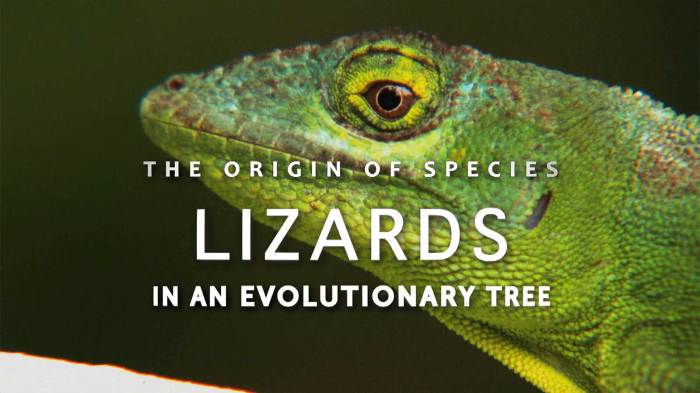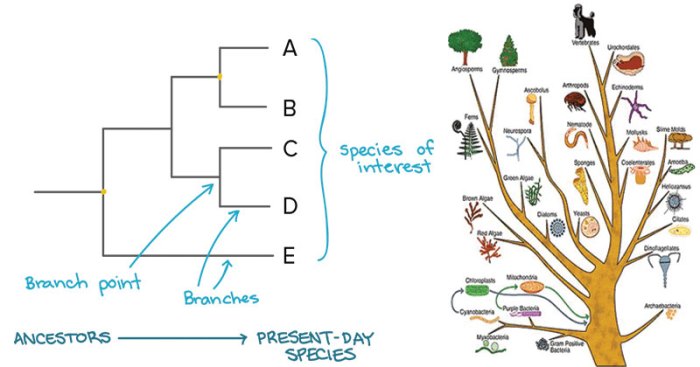The origin of species lizards in an evolutionary tree answers a fundamental question in herpetology, tracing the lineage of these remarkable creatures through the annals of time. This topic unveils the evolutionary tapestry of lizards, shedding light on their diversification, adaptation, and biogeographic distribution.
Prepare to embark on a captivating journey into the realm of lizard evolution, where scientific inquiry unravels the mysteries of their origins.
Evolutionary History of Lizards

Lizards are a diverse group of reptiles with a rich evolutionary history. They first appeared during the Late Permian period, approximately 250 million years ago. The early lizard ancestors were small, terrestrial animals that resembled modern skinks. Over time, lizards diversified into a wide range of forms, including arboreal, fossorial, and aquatic species.
A major evolutionary event in lizard history was the development of bipedalism in the Triassic period. This adaptation allowed lizards to move more efficiently and escape predators. Another important evolutionary event was the development of the ability to shed their tails.
This adaptation provides lizards with a defense mechanism against predators, as they can shed their tail to distract the predator while they escape.
Today, lizards are found on every continent except Antarctica. They are a highly successful group of reptiles, with over 6,000 known species.
Adaptive Radiation of Lizards
Lizards have undergone a remarkable adaptive radiation, colonizing a wide range of habitats and ecological niches. This radiation has been driven by a combination of morphological and physiological adaptations.
One of the most striking examples of lizard adaptation is the development of flight in the genus Draco. These lizards have evolved flaps of skin on their sides that allow them to glide from tree to tree.
Another example of lizard adaptation is the development of venom in the genus Heloderma. These lizards are the only venomous lizards in the United States.
Biogeographic Patterns of Lizard Distribution, The origin of species lizards in an evolutionary tree answers
Lizards are found on every continent except Antarctica. However, their distribution is not uniform. The greatest diversity of lizards is found in the tropics, with the highest concentrations in the Amazon rainforest and the Congo Basin.
The distribution of lizards is influenced by a variety of factors, including climate, habitat, and the presence of predators and competitors.
Comparative Anatomy and Morphology of Lizards
Lizards exhibit a wide range of anatomical and morphological adaptations that reflect their diverse lifestyles.
One of the most distinctive features of lizards is their long, slender bodies. This body shape allows lizards to move quickly and easily through their environment.
Lizards also have a well-developed sense of sight and hearing. Their eyes are located on the sides of their heads, giving them a wide field of vision. Their ears are located on the sides of their heads, and they can detect a wide range of sounds.
Molecular Phylogenetics and Lizard Evolution
Molecular phylogenetics has played a major role in our understanding of lizard evolution. By comparing the DNA sequences of different lizard species, scientists have been able to reconstruct the evolutionary relationships among lizards.
Molecular phylogenetics has helped to resolve a number of long-standing questions about lizard evolution. For example, it has shown that the iguanas and agamas are more closely related to each other than they are to the geckos.
Conservation and Threats to Lizards
Lizards are facing a number of threats, including habitat loss, climate change, and invasive species. These threats are putting lizard populations at risk, and some species are now considered endangered.
Conservation efforts are underway to protect lizards and their habitats. These efforts include habitat protection, captive breeding programs, and public education campaigns.
FAQs: The Origin Of Species Lizards In An Evolutionary Tree Answers
What is the significance of an evolutionary tree in understanding lizard origins?
An evolutionary tree, or phylogenetic tree, depicts the evolutionary relationships among different lizard groups. It provides a visual representation of their shared ancestry and divergence over time, allowing scientists to trace the origin and diversification of lizard species.
How have lizards adapted to various habitats and ecological niches?
Lizards exhibit remarkable adaptive radiation, having evolved diverse morphological and physiological adaptations that enable them to colonize a wide range of habitats. These adaptations include specialized body shapes, limbs, scales, and sensory organs that enhance their survival in specific ecological niches.
What factors contribute to the biogeographic patterns of lizard distribution worldwide?
Biogeographic patterns of lizard distribution are influenced by a combination of factors, including climate, habitat availability, geographic barriers, and dispersal events. These factors shape the distribution and diversity of lizard species across different regions of the world.


